| |
HCV Screening & Treatment Saves Billions$$$ & Prevents Liver Cancer, Diseases & Deaths
"Treating all Medicaid patients with chronic HCV...... resulted in a 39.4% ($3.8 billion) savings"
|
| |
| |
Download the PDF here
".....'Hospitalizations And Costs Associated With Hepatitis C And Advanced Liver Disease Continue To Increase' -" Hospitalization rates for hepatitis C per 100,000 people increased significantly from 4.76 in 2004-05 to 13.81 in 2010-11-an increase of 190 percent."
Test & Treat - Routine & mandated screening
"Implementation of the recommended screening of people born in the period 1945-65 and of more effective treatment for hepatitis C in the United States has the potential to reverse the rising morbidity and costs from hepatitis C."
"Screening all individuals in the population generates $0.68 billion in social value if diagnosed patients are treated in fibrosis stages F3-F4 compared with $824 billion if all diagnosed patients in stages F0-F4 are treated"
"Over a 20-year horizon, private payers experience overall savings of $10 billion to $14 billion after treatment costs."
"Medicare receives a larger net benefit if private treatment coverage is expanded to F0-F4. After 20 years, Medicare's medical expenditures declined by $9 billion and treatment costs declined by $2 billion, for a net benefit of $11 billion ($1134 per HCV-positive Medicare beneficiary)."
"People with HCV have higher rates of comorbidities such as diabetes, heart disease compared to people without HCV in the general public. Treatment & cure of HCV may reduce the impact of these comorbidities."
"Treatment & curing HCV reduces greatly the risk for those with HCV for liver cancer, liver diseases or death" see the tables below and links to original articles"...... "People with HCV have a higher prevalence of comorbidity and multimorbidity compared to the general population. While HCV treatment was not associated with multimorbidity, people with substance use disorder were less likely to be treated. Our results point to the need for integrated, comprehensive models of care delivery for people with HCV."
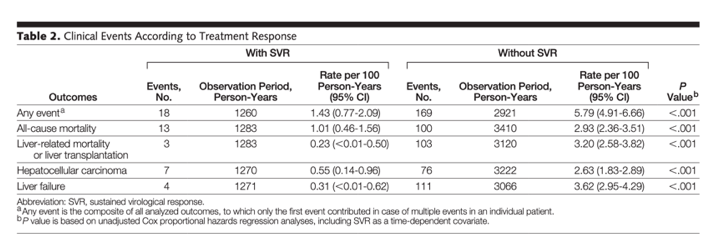
https://www.natap.org/2017/HCV/joc120128_2584_2593t2.pdf
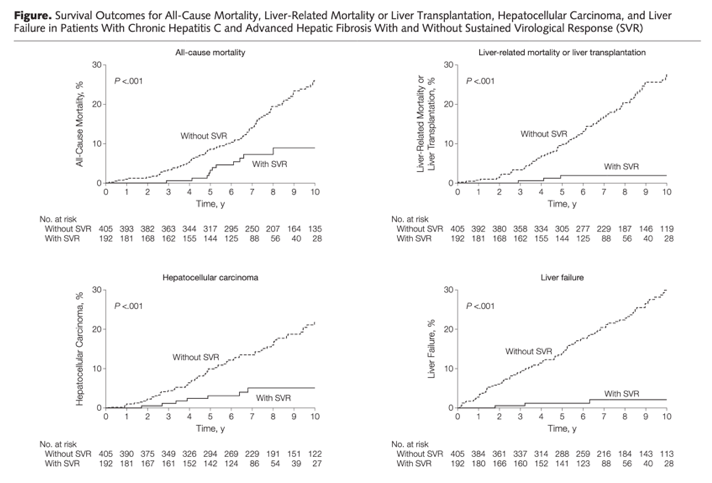
---------------------------------------------
"Impact of Direct-acting Antiviral Therapy on End Stage Liver Disease Among Individuals with Chronic Hepatitis C and Substance Use Disorders"
For both groups of patients, those with and without an SUD, treatment with DAAs resulted in a lower incidence of DCC and HCC when compared to no treatment; this finding further confirms the recommendations of the current treatment guidelines which suggest that HCV antiviral therapy is feasible in patients with an SUD and should be provided as indicated to avoid the development of liver complications. In fact, we found that those with an SUD who were not treated had a significantly higher risk of developing DCC while those with an SUD and cirrhosis had a significantly higher risk for developing both DCC and HCC compared to those untreated without an SUD. Such a finding suggests that having an SUD may confer a more rapid progression to end stage liver disease especially if one has been diagnosed with ALD or uses alcohol with opioids or other drugs (polysubstance use disorder), most likely due to the synergic hepatotoxic effect of HCV and alcohol.
https://www.natap.org/2021/HCV/021021_02.htm
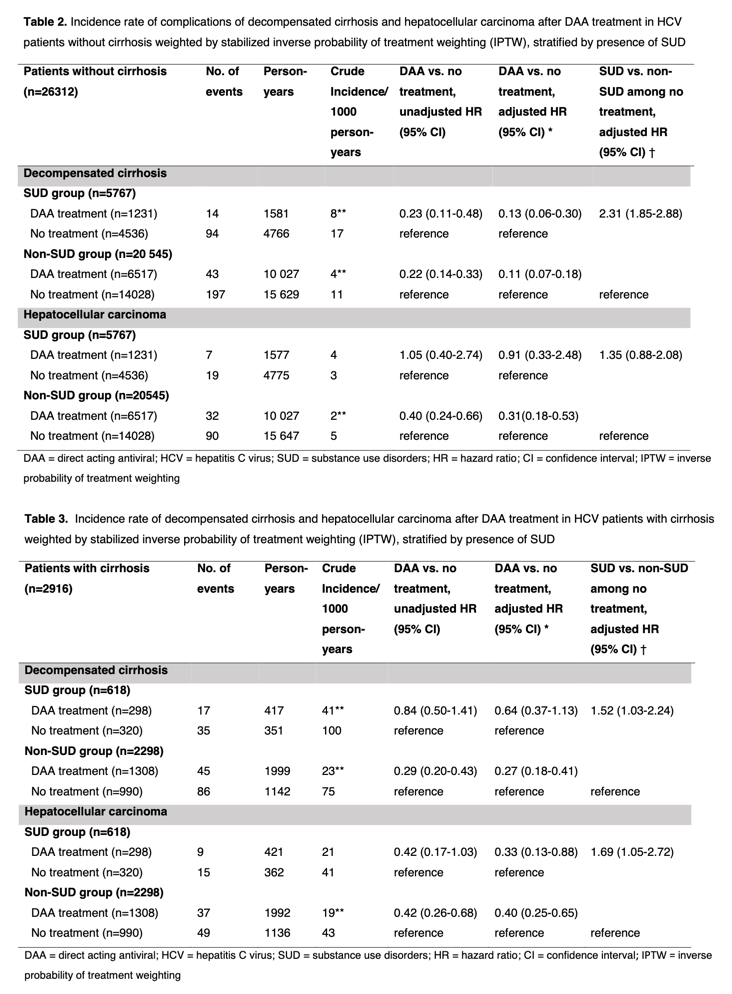
--------------------------------------------
.....'Hospitalizations And Costs Associated With Hepatitis C And Advanced Liver Disease Continue To Increase'.....Implementation of the recommended screening of people born in the period 1945-65 and of more effective treatment for hepatitis C in the United States has the potential to reverse the rising morbidity and costs from hepatitis C........ HCV group had greater multimorbidity (prevalence ratio (PR) 1.38, 95% confidence interval (CI) 1.20 to 1.58) and physical-mental health multimorbidity (PR 2.71, 95% CI 2.29-3.20) compared to the general population. Specifically, prevalence ratios for people with HCV were significantly higher for diabetes, renal failure, cancer, asthma, chronic obstructive pulmonary disease, substance use disorder, mood and anxiety disorders and liver failure. HCV treatment and cure were not associated with multimorbidity, but treatment prevalence was significantly lower among middle-aged individuals with substance use disorders despite no differences in prevalence of cure among those treated."
We modeled HCV progression and transmission to analyze the costs and benefits of investment in screening and treatment over a 20-year time horizon. Results: Expanded screening policies generated the largest value to society. However, this value is constrained by the availability of treatment to diagnosed patients. Screening all individuals in the population generates $0.68 billion in social value if diagnosed patients are treated in fibrosis stages F3-F4 compared with $824 billion if all diagnosed patients in stages F0-F4 are treated. Moreover, increased screening generates cumulative net social value by year 8 to 9 under expanded treatment policies compared with 20 years if only patients in stages F3-F4 are treated. Conclusions: Although increasing screening for HCV may generate some value to society, only when paired with expanded access to treatment at earlier disease stages will it produce considerable value. Such a "test and treat" strategy is likely to entail higher short-term costs but also yield the greatest social benefits.
https://www.ajmc.com/view/value-of-expanding-hcv-screening-and-treatment-policies-in-the-united-states
----------------------------------
Take-Away Points
Although the treatment costs for hepatitis C virus (HCV) are borne immediately, many benefits of treatment (eg, improved quality of life, longer survival) accrue in the future. Private payers with high beneficiary turnover may be reluctant to cover HCV treatment today, but foregoing treatment today results in larger future healthcare costs for both Medicare and private payers.
• Expanding private coverage of HCV treatments would generate $10 billion to $14 billion in private-payer savings and $4 billion to $11 billion in spillover benefits to Medicare after 20 years.
• Costs of private-coverage expansion exceed benefits for private payers in the short term; however, this investment would break even after 16 to 17 years.
• Total social value of comprehensive HCV treatment is positive for society, but private insurers do not have the incentive to provide comprehensive HCV treatment.
https://cdn.sanity.io/files/0vv8moc6/ajmc/f0f3331cc5cf3cbae12cb196901f60c80724c186.pdf/AJMC_HCV_05%20SI_2016_Moreno%20(final).pdf

Treating all eligible Medicaid patients with LDV/SOF, regardless of fibrotic stage, was projected to result in 36,752 fewer cases of cirrhosis; 1739 fewer liver transplants; 8169 fewer cases of hepatocellular carcinoma; 16,173 fewer HCV-related deaths; 0.84 additional life-years per patient; and 1.03 additional quality-adjusted life-years per patient.
Treating all Medicaid patients with chronic HCV using LDV/SOF resulted in a 39.4% ($3.8 billion) savings and decreased the proportion of total costs attributable to downstream costs of care to 18.3%.
https://www.ajmc.com/view/treating-medicaid-patients-with-hepatitis-c-clinical-and-economic-impact

With expanded HCV treatment coverage, private payers experience reduced medical expenditures in the 3-to-5-year time horizon; however, they still face higher treatment costs. Over a 20-year horizon, private payers experience overall savings of $10 billion to $14 billion after treatment costs. The expansion of coverage by private payers generates positive spillover benefits to Medicare of $0.3 billion to $0.7 billion over a 5-year horizon, and $4 billion to $11 billion over a 20-year horizon.
https://www.ajmc.com/view/costs-and-spillover-effects-of-private-insurers-coverage-of-hepatitis-c-treatment
Medicare receives a larger net benefit if private treatment coverage is expanded to F0-F4. After 20 years, Medicare's medical expenditures declined by $9 billion and treatment costs declined by $2 billion, for a net benefit of $11 billion ($1134 per HCV-positive Medicare beneficiary). In both alternative scenarios, private payers with time horizons of less than 20 years have the incentive to restrict treatment coverage, even though this policy harms both Medicare and private insurers in the long term. Figure 2 makes clear, however, that private payers do not enjoy the same net benefit as Medicare in the short term, because they bear the upfront treatment costs. Private payers face increased total costs of $25 billion to $78 billion after 5 years of expanding treatment. It takes roughly 16 to 17 years for private payers to break even on their upfront investment in treatment; after 20 years, they enjoy net savings of $10 billion to $14 billion. When treatment is expanded to F0-F4, net benefits to Medicare are 2.5 times higher compared with expanding to F2-F4. In addition, despite 5-year costs that are almost 3 times larger compared to expansion to F2-F4, expanding to F0-F4 results in an additional $4 billion in savings to private payers over a 20-year period.
Expanding HCV treatment coverage also greatly benefits society, through both reduced mortality and improved health-related quality of life for treated patients.39 Relative to treating at stages F3-F4, expanding treatment to F2-F4 generates 0.9 million additional discounted life-years over a 20-year period, and this figure increases to 1.17 million discounted QALYs after applying health utilities to the model population. Similarly, expansion to F0-F4 generates 1.7 million discounted life-years and 2.35 million QALYs over 20 years, relative to treating F3-F4.
-------------------------
In the United States, the annual age-adjusted incidence rate for HCC (liver cancer) tripled between 1975 and 2005, rising from 1.6 to 4.9 per 100,000, with approximately 20,000 new cases diagnosed annually (3-5). This increase is attributed to increases in hepatitis C virus (HCV) infection and possibly obesity (6). Despite efforts aimed at early cancer detection through surveillance programs, a substantial proportion of patients are diagnosed at advanced stages that are unamenable to curative treatment, and the 5-year survival rate has remained below 12% (7).
-----------------------------------
Hospitalizations And Costs Associated With Hepatitis C And Advanced Liver Disease Continue To Increase.....Implementation of the recommended screening of people born in the period 1945-65 and of more effective treatment for hepatitis C in the United States has the potential to reverse the rising morbidity and costs from hepatitis C.
Disease burden models have predicted worsening morbidity of liver disease caused by hepatitis C in the United States. The aim of this study was to determine the trend in hospitalizations caused by hepatitis C and advanced liver disease. We analyzed data for the period 2004-11 from the Nationwide Inpatient Sample, the largest nationwide all-payer hospital inpatient care database. Hospitalization rates for hepatitis C per 100,000 people increased significantly from 4.76 in 2004-05 to 13.81 in 2010-11-an increase of 190 percent. Hospitalization rates for advanced liver disease also increased, particularly for hepatorenal syndrome (93 percent) and portal hypertension (62 percent). Hepatitis C was the principal diagnosis for 64,867 hospitalizations in 2010-11, resulting in a total charge of $3.5 billion. We found nationwide trends in increasing morbidity and medical costs for advanced liver disease associated with hepatitis C. Our findings suggest that hepatitis C is a public health problem and has been growing in magnitude in recent years. Stakeholders and policy makers should implement both recommended screenings for people born in the period 1945-65 and more effective treatment for hepatitis C, which have the potential to reverse the rising morbidity and costs of hepatitis C.
We also observed increases in hospitalization for advanced liver disease sequelae, particularly hepatorenal syndrome, portal hypertension, ascites, and liver cancer.
The increased morbidity related to hepatitis C was associated with large and increasing medical costs. The total charge of hospitalizations principally caused by hepatitis C reached $3.5 billion in 2010-11 and more than tripled during the study period (291 percent). Increased costs were also observed for diagnoses of advanced liver disease (44 percent).
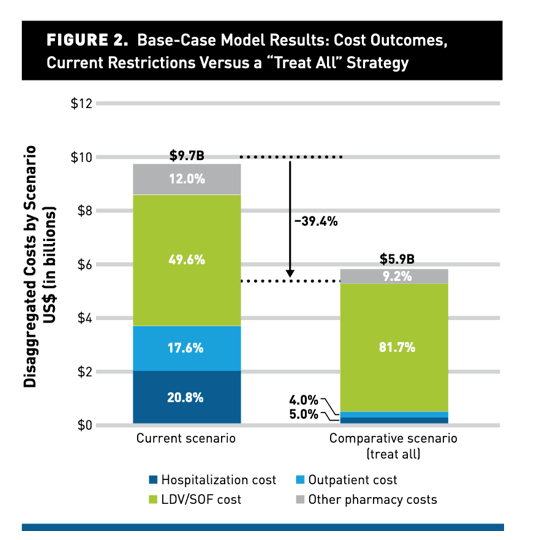
--------------------------------
HCV-infected individuals have higher prevalence of comorbidity and multimorbidity: a retrospective cohort study
Results
The mean age of the study population was 54.5 years (SD 11.4), 65% were male. Among those with HCV, 4% were HIV co-infected, 26% had liver cirrhosis, 47% received DAA treatment, and 57% were cured of HCV. After accounting for age and sex differences, the HCV group had greater multimorbidity (prevalence ratio (PR) 1.38, 95% confidence interval (CI) 1.20 to 1.58) and physical-mental health multimorbidity (PR 2.71, 95% CI 2.29-3.20) compared to the general population. Specifically, prevalence ratios for people with HCV were significantly higher for diabetes, renal failure, cancer, asthma, chronic obstructive pulmonary disease, substance use disorder, mood and anxiety disorders and liver failure.
HCV treatment and cure were not associated with multimorbidity, but treatment prevalence was significantly lower among middle-aged individuals with substance use disorders despite no differences in prevalence of cure among those treated.
Conclusion
People with HCV have a higher prevalence of comorbidity and multimorbidity compared to the general population. While HCV treatment was not associated with multimorbidity, people with substance use disorder were less likely to be treated. Our results point to the need for integrated, comprehensive models of care delivery for people with HCV.
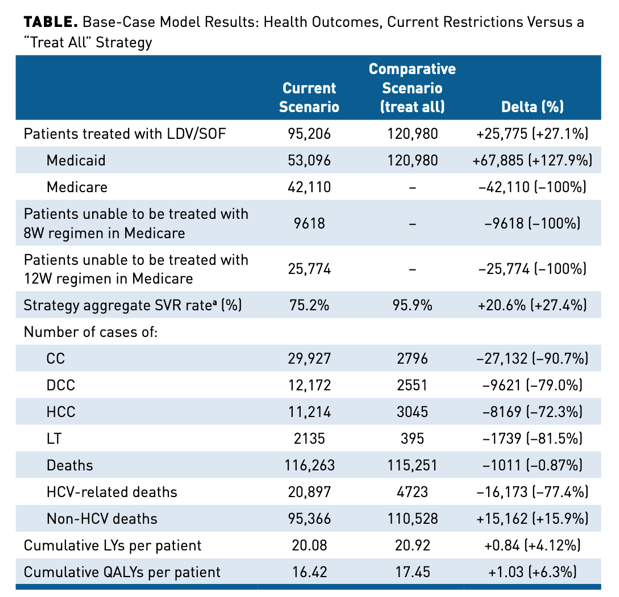
| |
| |
| |
|
|
|